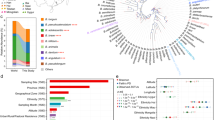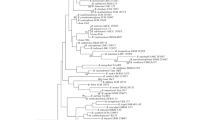Abstract
Centenarians constitute a significant subpopulation in the Bama County of Guangxi province in China. The beneficial effects of intestinal microbiota, especially bifidobacteria of centenarians, have been widely accepted; however, knowledge about Bifidobacterium species in centenarians is not adequate. The aim of this study was to investigate the quantity and prevalence of fecal Bifidobacterium in healthy longevous individuals. Fecal samples from eight centenarians from Bama (aged 100 to 108 years), eight younger elderlies from Bama (aged 80 to 99 years), and eight younger elderlies from Nanning (aged 80 to 99 years) were analyzed using denaturing gradient gel electrophoresis, species-specific clone library, and quantitative polymerase chain reaction technology (qPCR). A total of eight different Bifidobacterium species were detected. B. dentium, B. longum, B. thermophilum, B. pseudocatenulatum/B. catenulatum, and B. adolescentis were common in fecal of centenarians and young elderly. B. minimum, B. saecularmay/B. pullorum/B. gallinarum, and B. mongoliense were found in centenarians but were absent in the younger elderlies. In addition, Bifidobacterium species found in centenarians were different from those found in Bama young elderly and Nanning young elderly, and the principal differences were the significant increase in the population of B. longum (P < 0.05) and B. dentium (P < 0.05) and the reduction in the frequency of B. adolescentis (P < 0.05), respectively. Centenarians tend to have more complex fecal Bifidobacterium species than young elderlies from different regions.


Similar content being viewed by others
References
Andriantsoanirina V, Allano S, Butel MJ, Aires J (2013) Tolerance of Bifidobacterium human isolates to bile, acid and oxygen. Anaerobe 21:39–42. doi:10.1016/j.anaerobe.2013.04.005
Anonymous (1996) Use of geographic information systems in epidemiology (GIS-Epi). Epidemiological Bulletin 17(1): 1-6
Benno Y, Endo K, Mizutani T, Namba Y, Komori T, Mitsuoka T (1989) Comparison of fecal microflora of elderly persons in rural and urban areas of Japan. Appl Environ Microbiol 55(5):1100–1105
Brooks-Wilson AR (2013) Genetics of healthy aging and longevity. Hum Genet 132(12):1323–1338
Dong P, Yang Y, W-p Wang (2010) The role of intestinal bifidobacteria on immune system development in young rats. Early Hum Dev 86(1):51–58. doi:10.1007/s00439-013-1342-z
Drago L, Toscano M, Rodighiero V, De Vecchi E, Mogna G (2012) Cultivable and pyrosequenced fecal microflora in centenarians and young subjects. J Clin Gastroenterol 46(9):S81–S84. doi:10.1097/MCG.0b013e3182693982
Gagnon M (2007) Rôle des probiotiques lors d’ infections entériques d’ origine bactérienne et virale: analysesin vitroet étudesin vivo chez des modèles murins, Université Laval
Junick J, Blaut M (2012) Quantification of Human Fecal Bifidobacterium Species by Use of Quantitative Real-Time PCR Analysis Targeting the groEL Gene. Appl Environ Microbiol 78(8):2613–2622. doi:10.1128/AEM.07749-11
Kaur IP, Kuhad A, Garg A, Chopra K (2009) Probiotics: delineation of prophylactic and therapeutic benefits. J Med Food 12(2):219–235. doi:10.1089/jmf.2007.0544
Kubota A, He F, Kawase M, Harata G, Hiramatsu M, Iino H (2011) Diversity of intestinal bifidobacteria in patients with Japanese cedar pollinosis and possible influence of probiotic intervention. Curr Microbiol 62(1):71–77. doi:10.1007/s00284-010-9667-5
Lederberg J (2000) Infectious history. Science 288(5464):287–293. doi:10.1126/science.288.5464.287
Liu X, Zou Q, Zeng B, Fang Y, Wei H (2013) Analysis of fecal Lactobacillus community structure in patients with early rheumatoid arthritis. Curr Microbiol 6 7(2):170–176. doi:10.1007/s00284-013-0338-1
Liu Y, Li Y, Jiang Y, Li H, Wang W, Yang L (2013) Effects of soil trace elements on longevity population in China. Biol Trace Elem Res 153(1–3):119–126. doi:10.1007/s12011-013-9673-0
Mathys S, Lacroix C, Mini R, Meile L (2008) PCR and real-time PCR primers developed for detection and identification of Bifidobacterium thermophilum in faeces. BMC Microbiol 8:1–8. doi:10.1186/1471-2180-8-179
Matsuki T, Watanabe K, Fujimoto J, Kado Y, Takada T, Matsumoto K, Tanaka R (2004) Quantitative PCR with 16S rRNA-Gene-targeted species-specific primers for analysis of human intestinal bifidobacteria. Appl Environ Microbiol 70(1):167–173. doi:10.1128/AEM.70.1.167-173.2004
Mueller S, Saunier K, Hanisch C, Norin E, Alm L, Midtvedt T, Cresci A, Silvi S, Orpianesi C, Verdenelli MC, Clavel T, Koebnick C, Zunft HJF, Dore J, Blaut M (2006) Differences in fecal microbiota in different European study populations in relation to age, gender, and country: a cross-sectional study. Appl Environ Microbiol 72(2):1027–1033. doi:10.1128/AEM.72.2.1027-1033.2006
Muyzer G, de Waal EC, Uitterlinden AG (1993) Profiling of complex microbial populations by denaturing gradient gel electrophoresis analysis of polymerase chain reaction-amplified genes coding for 16S rRNA. Appl Environ Microbiol 59(3):695–700
Ouwehand AC, Bergsma N, Parhiala R, Lahtinen S, Gueimonde M, Finne-Soveri H, Strandberg T, Pitkala K, Salminen S (2008) Bifidobacterium microbiota and parameters of immune function in elderly subjects. Fems Immunol Med Microbial 53(1):18–25. doi:10.1111/j.1574-695X.2008.00392.x
Partridge L (2012) Diet and healthy aging. New Engl J Med 367(26):2550–2551. doi:10.1056/NEJMcibr1210447
Reichald A, Brenne SA, Spruss A, Forster-Fromme K, Bergheim I, Bischoff SC (2014) Bifidobacterium adolescentis protects from the development of nonalcoholic steatohepatitis in a mouse model. J Nutr Biochem 25(2):118–125. doi:10.1016/j.jnutbio.2013.09.011
Riedel CU, Foata F, Goldstein DR, Blum S, Eikmanns BJ (2006) Interaction of bifidobacteria with Caco-2 cells—adhesion and impact on expression profiles. Int J Food Microbiol 110(1):62–68. doi:10.1016/j.ijfoodmicro.2006.01.040
Ritchie LE, Burke KF, Garcia-Mazcorro JF, Steiner JM, Suchodolski JS (2010) Characterization of fecal microbiota in cats using universal 16S rRNA gene and group-specific primers for Lactobacillus and Bifidobacterium spp. Vet Microbiol 144(1–2):140–146. doi:10.1016/j.vetmic.2009.12.045
Robine J-M, Herrmann FR, Arai Y, Willcox DC, Gondo Y, Hirose N, Suzuki M, Saito Y (2012) Exploring the impact of climate on human longevity. Exp Gerontol 47(9):660–671. doi:10.1016/j.exger.2012.05.009
Russell DA, Ross RP, Fitzgerald GF, Stanton C (2011) Metabolic activities and probiotic potential of bifidobacteria. Int J Food Microbiol 149(1):88–105. doi:10.1016/j.ijfoodmicro.2011.06.003
Satokari RM, Vaughan EE, Akkermans ADL, Saarela M, de Vos WM (2001) Bifidobacterial diversity in human feces detected by genus-specific PCR and denaturing gradient gel electrophoresis. Appl Environ Microbiol 67(2):504–513
Shi S, Liu S, Huang Q, Huang F, Wei Y (2012) Guangxizhuang autonomous county’s 2010 population census. Beijing, China
Suzuki S, Shimojo N, Tajiri Y, Kumemura M, Kohno Y (2007) Differences in the composition of intestinal Bifidobacterium species and the development of allergic diseases in infants in rural Japan. Clin Exp Allergy 37(4):506–511. doi:10.1111/j.1365-2222.2007.02676.x
Tiihonen K, Ouwehand AC, Rautonen N (2010) Human intestinal microbiota and healthy ageing. Ageing Res Rev 9(2):107–116. doi:10.1016/j.arr.2009.10.004
Toure R, Kheadr E, Lacroix C, Moroni O, Fliss I (2003) Production of antibacterial substances by bifidobacterial isolates from infant stool active against Listeria monocytogenes. J Appl Microbiol 95(5):1058–1069. doi:10.1046/j.1365-2672.2003.02085.x
Ventura M, Turroni F, Zomer A, Foroni E, Giubellini V, Bottacini F, Canchaya C, Claesson MJ, He F, Mantzourani M, Mulas L, Ferrarini A, Gao B, Delledonne M, Henrissat B, Coutinho P, Oggioni M, Gupta RS, Zhang Z, Beighton D, Fitzgerald GF, O’Toole PW, van Sinderen D (2009) The Bifidobacterium dentium Bd1 genome sequence reflects its genetic adaptation to the human oral cavity. PLoS Genet 5(12):1–18. doi:10.1371/journal.pgen.1000785
Watanabe K, Makino H, Sasamoto M, Kudo Y, Fujimoto J, Demberel S (2009) Bifidobacterium mongoliense sp nov., from airag, a traditional fermented mare’s milk product from Mongolia. Int J Syst Evol Microbial 59:1535–1540. doi:10.1099/ijs.0.006247-0
Woodmansey EJ, McMurdo MET, Macfarlane GT, Macfarlane S (2004) Comparison of compositions and metabolic activities of fecal microbiotas in young adults and in antibiotic-treated and non-antibiotic-treated elderly subjects. Appl Environ Microbiol 70(10):6113–6122. doi:10.1128/AEM.70.10.6113-6122.2004
Xu M, Wang B, Fu Y, Chen Y, Yang F, Lu H, Chen Y, Xu J, Li L (2012) Changes of fecal Bifidobacterium species in adult patients with hepatitis B virus-induced chronic liver disease. Microb Ecol 63(2):304–313. doi:10.1007/s00248-011-9925-5
Yuan J, Wei H, Zeng B, Tang H, Li W, Zhang Z (2010) Impact of neonatal antibiotic treatment on the biodiversity of the murine intestinal Lactobacillus community. Curr Microbiol 60(1):6–11. doi:10.1007/s00284-009-9492-x
Zhao L, Qiao X, Zhu J, Zhang X, Jiang J, Hao Y, Ren F (2011) Correlations of fecal bacterial communities with age and living region for the elderly living in Bama, Guangxi, China. J Microbiol 49(2):186–192. doi:10.1007/s12275-011-0405-x
Zhao L, Xu W, Ibrahim SA, Jin J, Feng J, Jiang J, Meng J, Ren F (2011) Effects of age and region on fecal microflora in elderly subjects living in Bama, Guangxi, China. Curr Microbiol 62(1):64–70. doi:10.1007/s00284-010-9676-4
Zihler A (2010) In vitro assessment of bacteriocinogenic probiotics for prevention and treatment of Salmonellain children using novelin vitrocontinuous colonic fermentation and cellular models, ETH Zurich
Zihler A, Gagnon M, Chassard C, Lacroix C (2011) Protective effect of probiotics on Salmonella infectivity assessed with combined in vitro gut fermentation-cellular models. BMC Microbiol 11:1–13. doi:10.1186/1471-2180-11-264
Acknowledgments
The present work was supported by the grants from the National Natural Science Foundation of China (No. 31371762), the “Bagui Scholars Distinguished Professor” Special Project and Innovation Project of Guangxi Graduate Education (No.YCBZ2014019). We thank Dr. Bo Wu (Guangxi University) and Dr. Peihong Shen (Guangxi University) for providing the experiment guidance for denaturing gradient gel electrophoresis (DGGE). We have no conflicts of interest to declare.
Author information
Authors and Affiliations
Corresponding authors
Rights and permissions
About this article
Cite this article
Wang, F., Huang, G., Cai, D. et al. Qualitative and Semiquantitative Analysis of Fecal Bifidobacterium Species in Centenarians Living in Bama, Guangxi, China. Curr Microbiol 71, 143–149 (2015). https://doi.org/10.1007/s00284-015-0804-z
Received:
Accepted:
Published:
Issue Date:
DOI: https://doi.org/10.1007/s00284-015-0804-z




